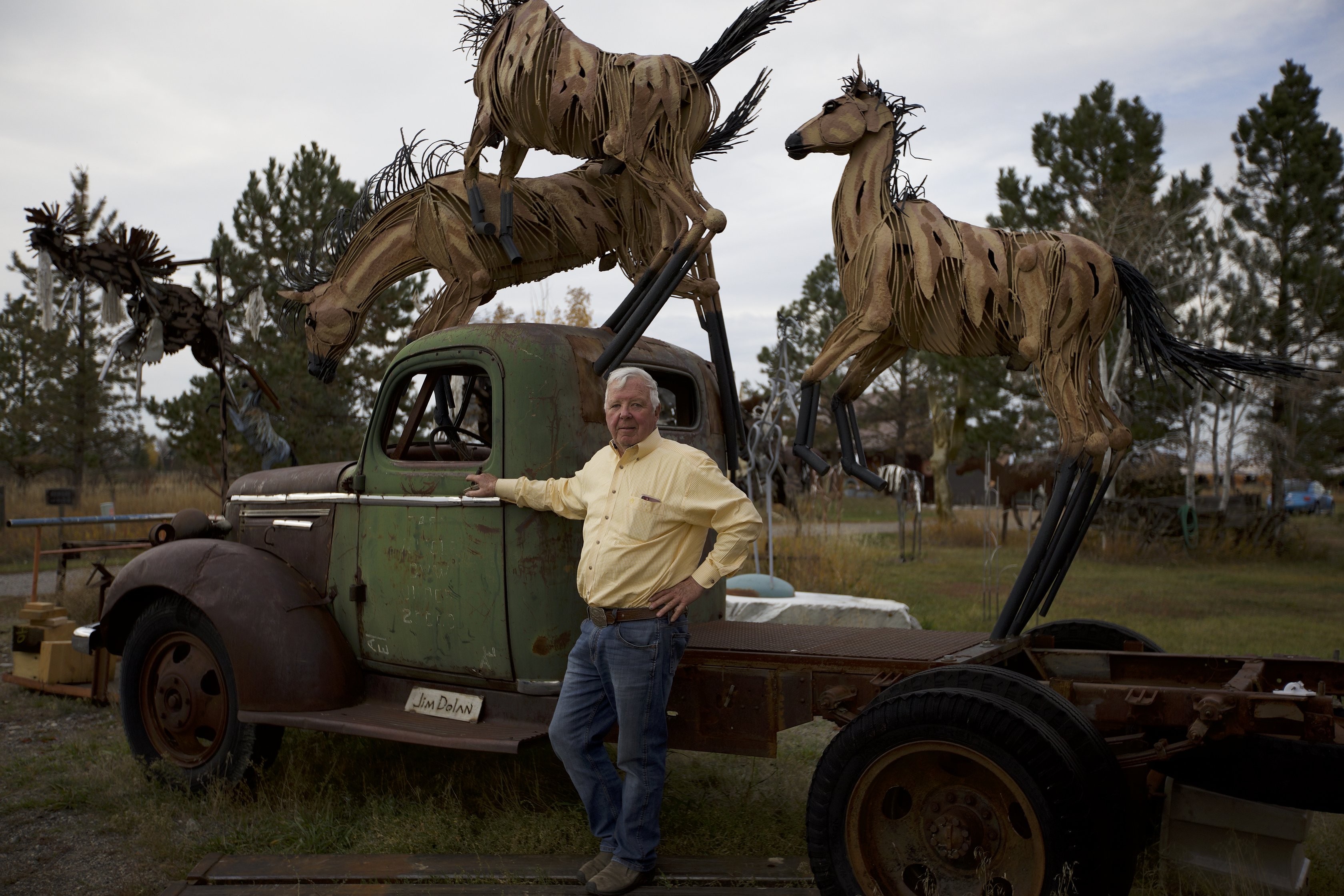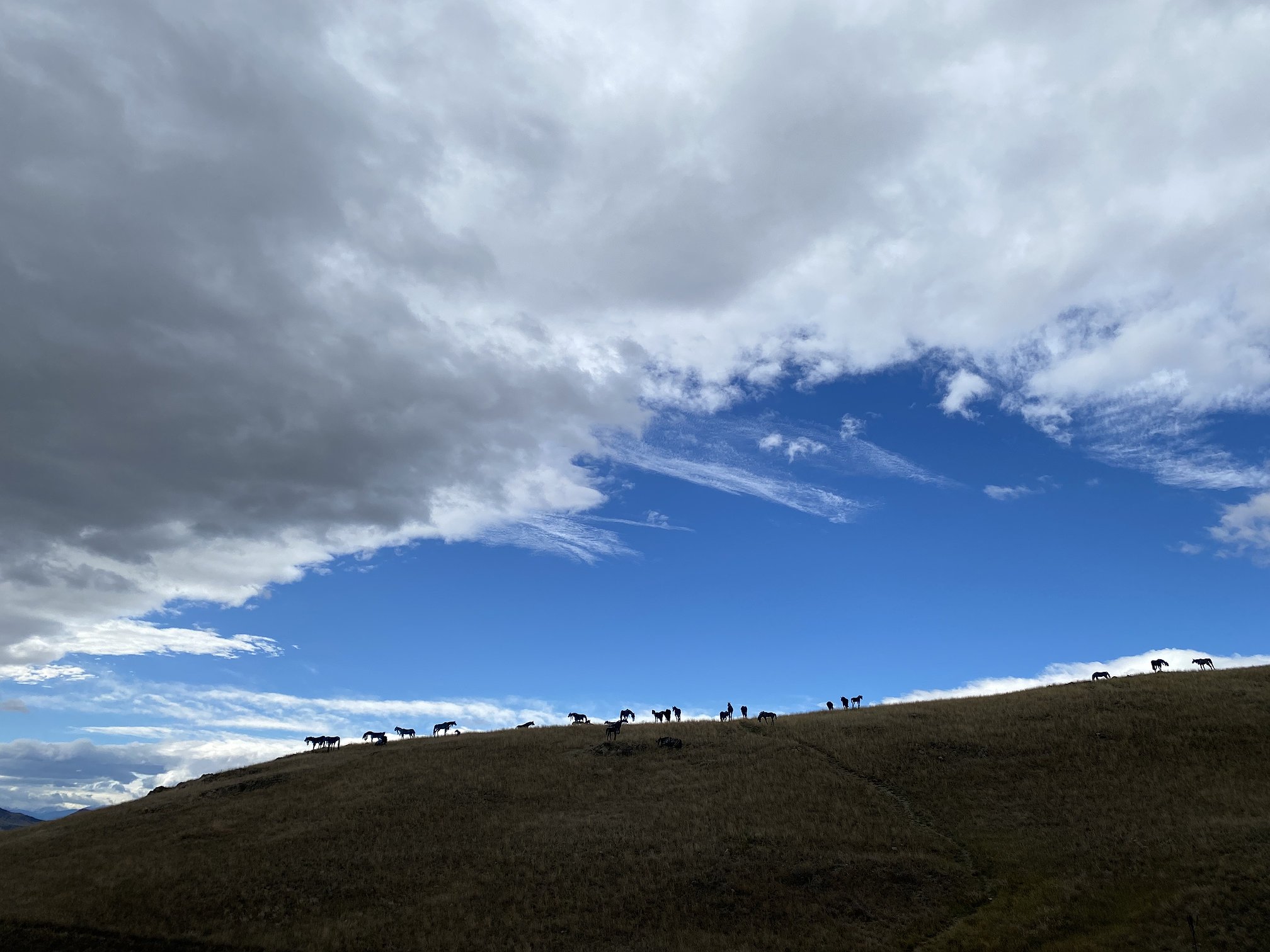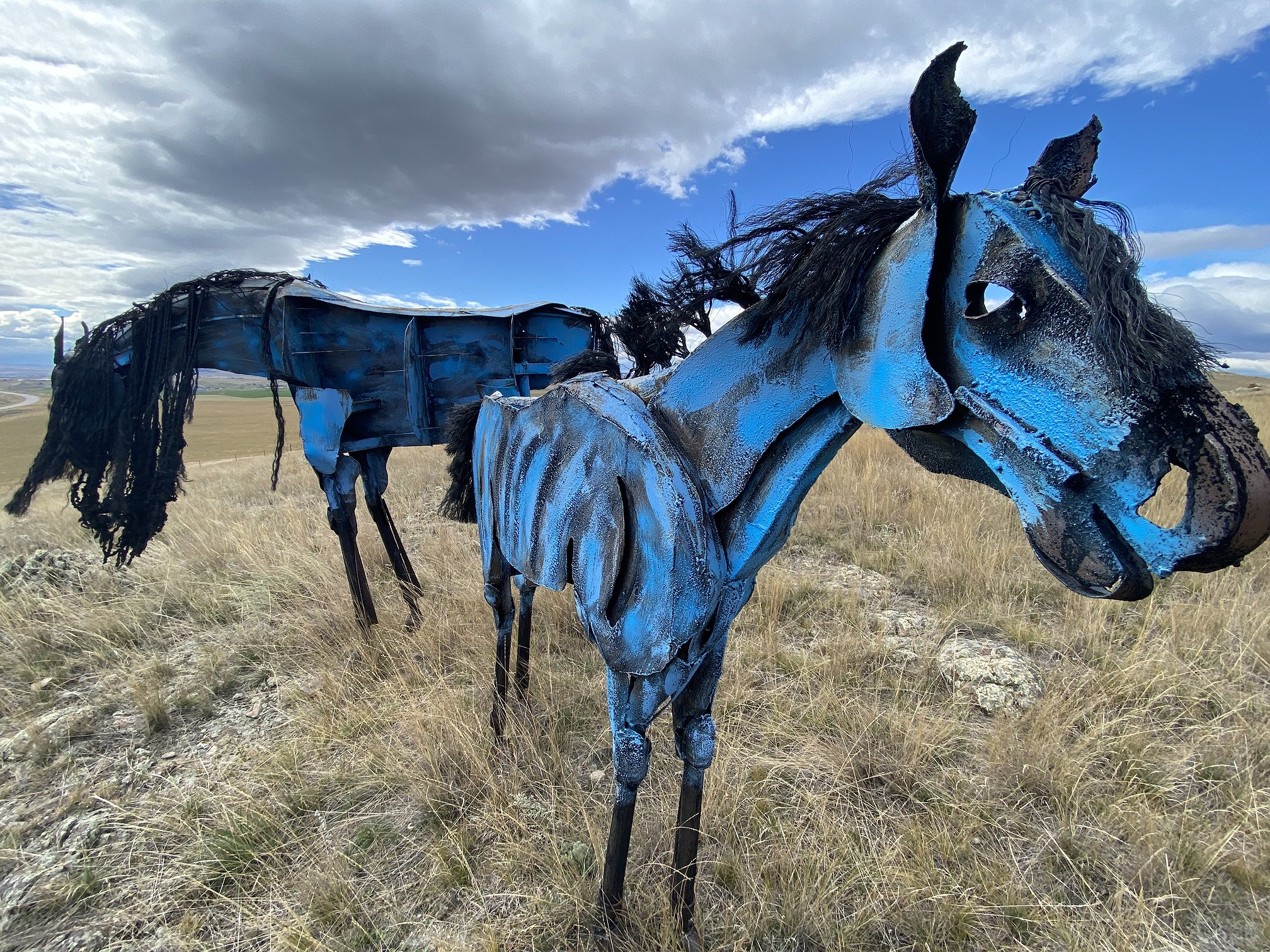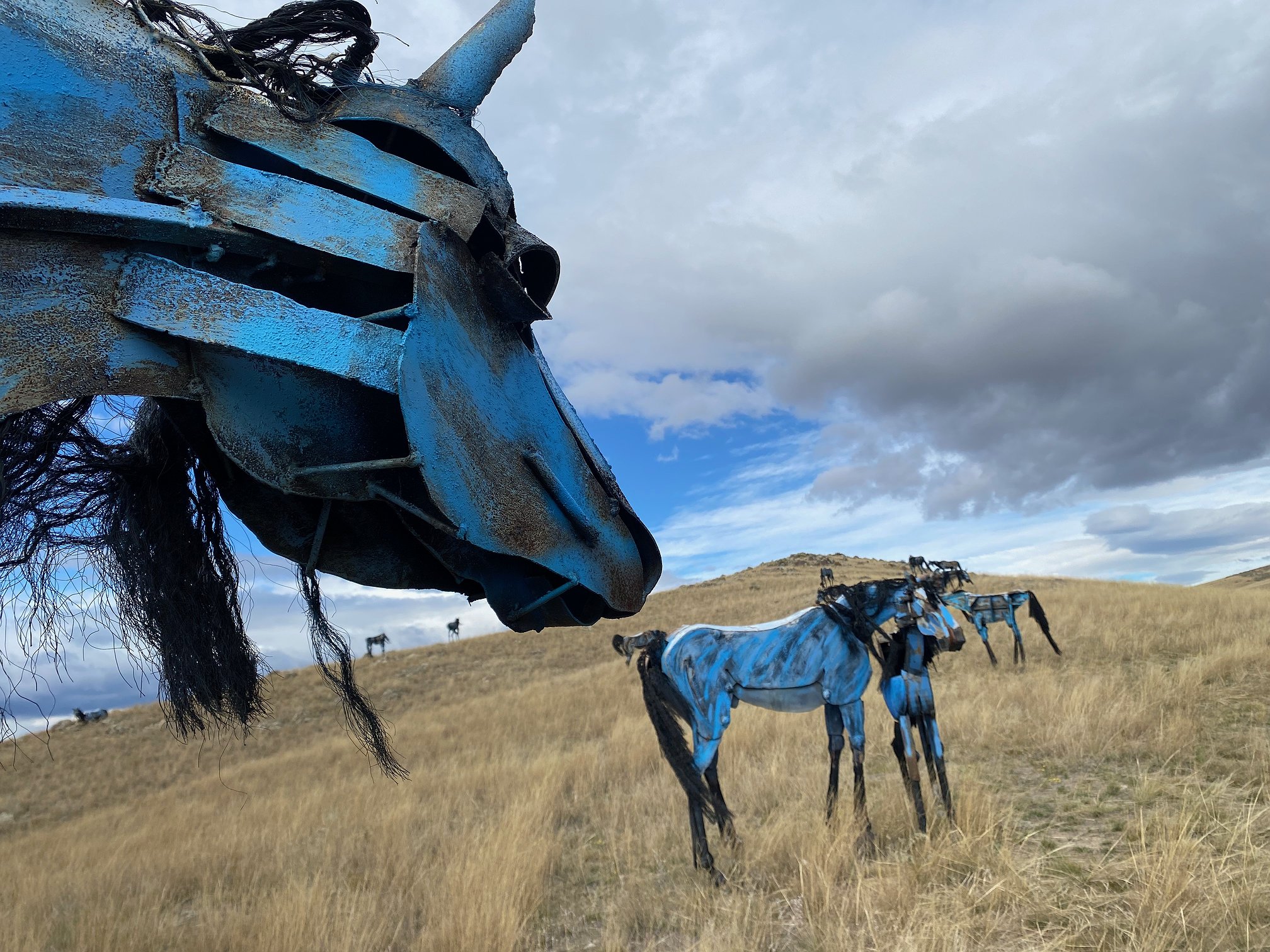Artist sees ‘Bleu Horses’ as gift to people of Montana
It’s hard to miss the entrance to Jim Dolan’s house. A larger-than-life steel monkey popping a wheelie on a motorcycle while holding up the peace sign welcomes you at the front.
“Clyde” has been greeting passersby on Airport Road outside of Belgrade for 40 years. Beyond the daredevil monkey is a playground of metallic creations created by Dolan. In the distance, you’ll see a crescent moon being used as a perch by Jeannette Rankin, a Montanan and the first woman elected to Congress. Bison with street-sweepers for manes stampede beside Rankin, looking so animated that you may want to pet their shapely metallic bodies. Elk and deer made from expandable steel have rusted the color of fur, and various birds appear to take flight.
Dolan’s creations are abundant in his yard and in public and private collections around the world, but his best-known work is on a hillside just outside of Three Forks.
“Bleu Horses,” a herd of 39 life-sized metal sculptures, stands sentinel across a 160-acre parcel of sloping prairie adjacent to Highway 287, which runs between Three Forks and Helena. Dolan installed the sculptures in 2013, just north of mile marker 104.
Horses are Dolan’s favorite animal to sculpt, and he’s been doing it since the 1960s. He was not commissioned to create the herd of horses; he just wanted to. In September, “Bleu Horses” turned 10 years old, and Dolan considers them his gift to the people of Montana.
“You can really hit people’s hearts with those horses,” Dolan said. “Everybody has a story of the first time they’ve seen them — thinking that they’re real horses. And it doesn’t disappoint them when they find out they aren’t real.”
Many of the horses are rigged with gears and pulley systems so their necks or torsos move in the wind. Their manes and tails are made from thick black rope, unwound so they flick about as if swatting flies. Muzzles shaped with expandable steel seem to ask for a caress, while ears stand straight, appearing to take in all that moves around them.
Blink a few times and you might miss the pull-off and thin trail leading up the hill where the horses reside.
“We didn’t want to put up a sign, partially because I want people to think they’re real horses,” Dolan said. “As soon as you mark them as art, then you lose something.”
Dean Folkvord, who owns the land where “Bleu Horses” stands, describes Dolan as a remarkable guy. “We really appreciate what he’s done,” Folkvord said. “He’s the kind of guy who is not necessarily interested in making the most money every day. He is more interested in doing something unusual or something special.”
Folkvord and Dolan made a handshake agreement a decade ago to place the horses on Folkvord’s land. At the time, he and his wife Hope owned Wheat Montana. After selling the business and the surrounding land, they kept the 160-acre parcel so the horses would continue to have a place to reside.
“It’s not farmable land, really. It’s never grown a crop,” Folkvord said. “There are no fences, so you can’t run livestock, and there is no water. This is the highest and best use of the land you could come up with.”
‘I WAS SUPPOSED TO BE AN ARTIST’
Dolan grew up in Livermore, California, where his parents owned a winery. He worked in the family business in high school, but he longed to move to Montana.
“I wanted to be a cowboy,” Dolan said. “I wanted to get into ranching.” His grandparents on his mother’s side homesteaded along the Tongue River above Birney but moved to the Bay Area during World War II. “But I always thought Montana was home,” he said.
After the family sold property they owned in California, they were able to purchase a ranch and move to Montana in the late 60s. Dolan was 18 at the time, the oldest of three brothers with an older sister. Dolan was the only one in the family who pursued art as a career.
“I knew I was supposed to be an artist,” he said. “There were some really tough times, you know, everybody goes through. I just said, ‘I’m supposed to be doing this,’ and I kept with it.”
Dolan attended Montana State University and took welding in college. Though he got a “C” in the class because he didn’t take the tests, he was riveted by sculpture.
“All my classmates thought I was totally weird because I was making all these little horses and using horseshoes for bases and things like this,” Dolan said.
With a surplus of metal the university had left over from World War II, Dolan had plenty of material that shaped his interest in creating life-sized animals.
“They gave me a place to work and all the materials and the welding supplies, and all I had to do was show up,” Dolan said. His good fortune during those days included being allowed to pay in-state tuition when he was unable to afford the out-of-state costs of attending MSU.
“They asked me, ‘What are you planning to do?’ I said, ‘I plan to live here the rest of my life and be an asset to the people of Montana.’ They made me an in-state student on the spot,” Dolan said.
Dolan graduated from Montana State University in 1970 with a degree in agricultural education, then pursued a master’s degree in agriculture. His pledge to be an asset to Montanans for the university’s support lingered.
“I always thought I would do one project for the people of Montana — a big project.”
A HORSE IS A HORSE, UNLESS …
In 2010, the country was struggling through a recession, and Dolan wasn’t doing great financially, either. Yet, he was committed to his pledge, which had percolated in his mind across the decades since graduation. For three years, he worked on “Bleu Horses.”
“I bought steel when I could buy it. And I just kept on working on those guys,” Dolan said. “I paid one full-time guy who worked with me. We just got into a rhythm. We usually had two or three going at once, and we just kept them going until we got them done.
“My friends, they were ready to call the guys in the white coats to come get me,” Dolan continued. “They said, ‘You don’t have any money. You’re doing this?’ ‘Yep. I’m going to do the “Bleu Horses.”’ I worked day and night.”
The horses are constructed with thick sheets of cut metal and covered in truck-bed liner, giving the bodies texture, and then painted various shades of blue that highlight the horses’ rib cages and muscled features.
When installing the sculptures on the hillside, Dolan anchored them to the land in ways that real horses would gather.
“I’ve been around horses a lot, but people who have horses said, ‘You put them up there perfectly.’ Because, they have groups, you know,” Dolan said. “There’s four in the back there on the hillside; they’re like the juvenile geldings. I call them the Gang of Four.”
The entire gang is named after the French word for blue. “I like blue, and I just thought that would be something that would stand out,” Dolan said. When he sought a website domain, bluehorses.com was already taken, so he changed course to use the French spelling “bleu,” “which is a lot more, you know, sexy.”
The horses have lived on the hill unscathed, with the exception of an incident right after they were installed when three were stolen.
“We noticed the tracks, and they went in the big coulee and did it at night,” said Folkvord, the landowner. “We put out an APB that the horses had gotten rustled.”
Folkvord and Dolan can laugh about it now, but at the time, “we were pissed,” Folkvord said. “Everyone was mad.”
The sheriff and residents in the area got involved, a $5,000 reward was offered and the case of the missing horses was written up in papers from San Jose to Salt Lake to New York, and even some international news outlets. A few months later, they were recovered. Although charges were never filed, “it was great publicity,” Dolan said.
HARD WORK, LONG HOURS
The inside of Dolan’s shop is just as eclectic as his yard. Horses in various stages stand tall: a rusty-bronze Appaloosa in the corner with thick round wire for a mane, a rosy-cheeked crimson horse with a tail of chains, a bucking horse covered in reflective tape looking like it tangled with a sign from a construction zone. In the center of the shop, there’s a grand piano Dolan is constructing from sheet and scrap metal, which will be adorned with a horse lounging on top.
“About half my work is commissioned and half is speculative,” Dolan said. He had the 4,000-square-foot workshop with 28-foot ceilings constructed 15 years ago, and prior to that, he was working in an unheated shop on his property a quarter of that size.
“The biggest piece I ever made is in Osaka, Japan — an eagle,” Dolan said, “and I made it in that little shop. It’s 27 feet tall with a 36-foot wingspan. To take it apart we had to saw it twice.”
Dolan’s studio assistant, Clinton Lesh, has been learning how to work big. He started working with Dolan and utilizing the studio for his own creations after graduating from MSU with a degree in art in 2021.
“I wanted to make big sculptures,” Lesh said, and when he met Dolan just two weeks before graduation, he was hired on the spot.
“He’s very generous,” Lesh said of Dolan. “He will help anybody, and he has donated many, many sculptures in his time. When it comes to his process of creating, there is no hesitation. He just dives in.”
Working as a farm and ranch hand for 40 years has taught Dolan discipline, and he works furiously on his projects, even when his kids were young. “A lot of hard work and long hours,” he said. “I’d put the kids to bed at 9 o’clock, then work for two more hours. Then I’d usually start at six in the morning.”
Dolan works with all kinds of metal, from expandable steel to stainless steel sheet metal to scrap metal, and he welds, bends, cuts, shapes, rusts, paints, sands, and sculpts his materials. As time has gone on, his work has become more full-bodied, appearing more and more realistic. He’s crafted life-sized giraffes, lions, caribou, wolves, foxes, waterfowl, and more from the animal kingdom, as well as humans. He’s a perpetual maker, always tinkering with something. His latest art piece is a fence on his property, made from engine rods and bed frames that came from the county jail.
“I have more ideas than I could do in my lifetime,” Dolan said. “The hardest part is narrowing them down and saying, when I start this, I want to get it done.”
ART NOT BOMBS
Dolan makes what he wants to make, and if people like it, he’s happy. If they don’t, he seems to be just as happy. He has the good fortune of a large backyard to hold his many creations, and his commissions keep him paid to do what he loves.
Yet, Dolan knows art is a powerful mood-changer, and after creating a riveting stainless-steel mustang he forged at a foundry in Anaconda, he decided to ship it to Ukraine.
The mustang is captivating, a regal horse fired at 1,100 degrees to turn the stainless steel an iridescent and permanent shade of blue. As the war in Ukraine waged on, Dolan decided to send the people of Bozeman’s sister city, Kopychyntsi, Ukraine, a horse.
“We ship them guns and bombs and weapons. I want to ship them art,” Dolan said. In partnership with Bozeman’s Ukrainian relief effort group, he arranged for the mustang to ship out earlier this year. After leaving the states, the horse spent three weeks in customs in Poland while it was sorted out that the artwork was a gift and not for sale, which would have required them to pay thousands of dollars in taxes. The horse has yet to arrive in Kopychyntsi, but the town’s mayor is expecting it and has an outdoor location selected, Dolan said.
“If I have a goal — which I really don’t because I have no idea what it feels like to be there — it is to make people smile,” Dolan said. “Something America does, more than a provider of arms. Go by it and smile. That’s all I want.”
Reflecting on 10 years of the horses on the hill, Dolan said what struck him the most was how touched people have been by his art. People have even told Dolan they want their ashes scattered on the hill with the horses.
“I don’t know what it is, but people totally love those guys,” he said. “I guess if someone doesn’t like them, they don’t tell me.”
Every few months, Dolan climbs the hill to check on the herd. He brushes out their tangled manes, and sometimes he’ll bring a couple of gallons of paint and “dress them up a little bit.”
“They all have a name too,” Dolan said. “I call them all ‘Bleu.’”
Anna Paige is a Montana-based arts journalist and co-host of "Resounds: Arts and Culture on the High Plains" on Yellowstone Public Radio.












